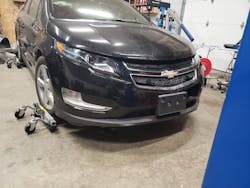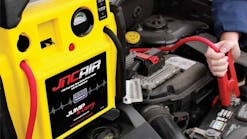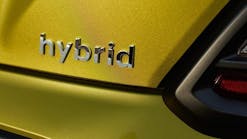In the world of key programming, we love those jobs where we can just cut a key program where everything works perfectly, and we are on our way. Unfortunately, that is not always the case. Take for example a situation that I built for myself. This could just as easily be a customer vehicle that you were called into a body shop to cut and program keys for.
I was at my local salvage yard, and out of the corner of my eye, I saw a Chevy Volt. I asked about the vehicle and the attendant said, “There are two of them, almost identical.” I went and checked them out, and found two 2015 Chevy Volt Hybrids, one wrecked in the front and one wrecked in the back.
The light bulb went off in my head, and I said, “I could build this and have a nice car to drive for cheap.” We made a deal on the two vehicles, and I hauled them home. Between the two vehicles, I had almost all the parts and pieces I needed to make one good car.
Once I had the car put together, it was time to make it run. This is where a normal customer or body shop would call in a locksmith to get keys made for the vehicle. I, on the other hand, purchased the keys myself and cut them to code for the Volt. The key cut worked perfectly in the door, then it was time to program to the vehicle.
The 2015 Volt is a push-button start vehicle, meaning there is no key slot to power on the ignition. I own a lot of tools and programmers, but this case was special. I didn’t know anything about this vehicle. What I did know was that the modules were going to need to be updated.
I had to replace the airbag module since the airbags had deployed, and I knew I would have to do J-2534 Programming to get the module to program to the vehicle. I couldn’t do any programming though until I had the key programmed to the vehicle to turn on and off the ignition. I also knew I would have codes in this vehicle. After the wreck who knows what the computers were seeing?
For this job, I knew I needed three tools already: a key programmer that can force on the ignition, a diagnostic tool to clear all the codes in the vehicle and perform module resets and memory relearns, and a J-2534 programming device to update the airbags and other modules.
Those three factors made my final tool choice an easy one: the Autel IM608. The IM608 was a new tool to me and understanding the tool and its flow, in my mind, was going to be a learning curve. I was totally wrong. The tool walked me through the process and even showed me illustrations and diagrams without having to go to an outside source. The IM608 includes key programming via the “IMMO” selection, the diagnostic functions I needed via the “Diagnose” selection and included the J-2534 device.
But I’m getting ahead of myself, let’s take this job one step at a time. The first step in this job was a stable battery supply. This was going to take some time. Once I got the ignition on, the lights would be on, the doors would be open, and this vehicle would be putting a draw on the battery.
Side note: Voltage is very important in programming. Whether it is just a key or updating the modules and systems, never underestimate the power of voltage. Ha, see what I did there?
Anyway, step 1.5 was to program the new keys to the vehicle. With the IM608, I was able to force on the ignition and light up the dash. I followed the prompts and went through the process. The key needed to be inserted into the programming ring, which the tool indicated would be located under the rubber cover on the compartment above the radio. I inserted the key in the slot, programmed key two, and the tool said ‘start the car’… but no dice! The car didn’t start, but the tool said the keys were programmed.
After I disconnected the tool from the car, I could turn the ignition on and off with the push-to-start button. I took the IM608 and backed out to the diagnostic screen. Now that I could power up the vehicle, I was able to read the codes and check out the system. There was no communication with the airbag module and lots of codes. That made sense, the airbag module had not been programmed yet, but a vehicle can run without an airbag module. Or can it?
Remember, this is a Chevy Volt. When a hybrid vehicle blows the airbags, the contacts in the battery release trying to protect the first responders. Without the airbag module being programmed, the contacts are still released, and the vehicle will not start.
Moving on to the third step of the process, I used the J-2534 interface with my PC. After purchasing the subscription from ACDelcoTDS and downloading all the Autel Drivers. I connected the PC to the J-2534 box, logged into ACDelcoTDS, and started the programming process. First, I programmed the airbag module, and while I was there, I checked the other modules for necessary updates. Any updates that were available and were not symptom specific, I completed. The process for J-2534 programming on this GM was not as difficult or as scary as I thought it would be. I just had to read the screen and follow directions.
With the first three steps done – keys programmed, diagnostics run, and module programmed – I tried to start the car, but still no luck. I still had the J2534 box plugged in, so I cleared all the codes and checked the module list. I noticed that I was missing Hybrid Control Module 1. That didn’t make any sense; I remembered seeing that module on the IM608 when I scanned for codes.
I connected back to the IM608 and went under diagnostics to do an all system scan, and there it was, Hybrid Control Module 1. This didn’t make sense. How could I see it on my aftermarket tool, but not on the OE program? Going into the ECU information, I noticed the VIN in this control module didn’t match the VIN on the car. When replacing this module, the original one was damaged, so I used the module from the donor car and plugged it in. On this model of vehicle, the OE doesn’t allow the VIN to be written or changed in this module. According to the OE, you must purchase a new module, then program it.
At $4,000 I was not about to go out and purchase a new module. Looking at the damaged module, the reason I didn’t use it in the first place was that the connector was damaged. After opening the case, I noticed that all the circuitry was intact, and there was no internal damage. Removing the board from the damaged housing, I was able to swap the entire circuit board into the donor case. Now I have the best of both cars. The circuit board with the proper VIN and a case that is not damaged.
No one likes to go to a job and not be able to finish it for the customer. In this case, if you were the locksmith that showed up to this job, there were issues beyond your control that would cause you a second trip or maybe an unpaid run because you could not get the vehicle running. The Autel IM608 is the only tool on the market, that I know of, that could have handled this job. Having key programming, diagnostics, and J-2534 programming all in one package made all the difference.
To view a video of Chad Schnitz, Autel's National Sales Manager - Strategic Accounts, demonstrating a key learn for a 2015 Chevy Volt using the IM608, click here.
Information provided by Autel


